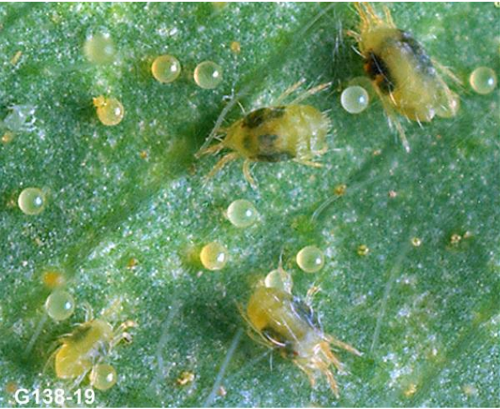Description: Twospotted spider mites, Tetranychus spp., are widespread on melon crops throughout the southwestern U.S, but only occasionally cause significant damage. Spider mites are very small and are difficult to see with the naked eye. Adults are about 0.45 mm long, have eight legs and an oval body. Tiny spherical eggs may be present as well as webbing. Spider mites develop numerous generations throughout each melon growing season. Under optimal conditions of high temperatures and low humidity, mites can complete their life cycle in about seven days.
Damage: Spider mites injure melons by puncturing the surface cells on the underside of leaves where they feed. This results in the destruction of chlorophyll and reduction in photosynthetic activity. Injured leaves become pale, stippled and can dry up and die under heavy infestations. Injury often is not noticed until reddish brown patches of affected plants appear in the field. Injury is most common in hot, dry weather from late spring to early fall when temperatures are favorable for rapid development. Light infestations can be tolerated, but severe injury can result in reduced yields and fruit quality.
Management: Spider mites feed on a large number of crops and weeds and will overwinter in soil and debris on the ground. Infestations in melons often begin with adults carried by wind from adjacent crops. Because dust favors spider mite populations, minimize dust by watering field roadways. Several natural enemies (including predatory mites and thrips, minute pirate bugs and lacewings) play an important role in regulating mite populations below economic injury levels. Predator populations should be encouraged by limiting chemical rates and using selective insecticides for other pests. Good irrigation and fertilization management can enhance plant tolerance to mites. No economic thresholds have been established for spider mites in the desert, however treatment with an acaricide is recommended when webbing occurs, damage is evident and predatory mites and thrips are absent. Although spider mites inhabit the undersurface of leaves, most of the new miticides are translaminar and can effectively reach the pests when properly applied to upper leaf surfaces. A number of effective miticides are available for melons including Agri-Mek, Oberon, Acramite, Miteus, Zeal and sulfur. If leafminers are present in the field, Agri-Mek is a good option. If whiteflies nymphs are beginning to build on older leaves, Oberon or Minecto Pro (cyantraniliprole+abamectin) may be an effective option for both pests.

Twospotted spider mites and eggs on underside of melon leaf (credit: Ralph E. Berry, Oregon St. Univ)
